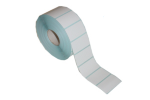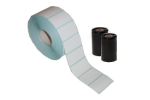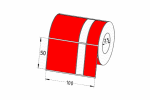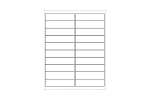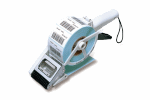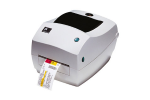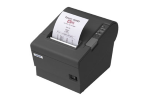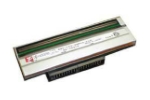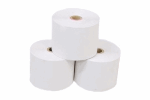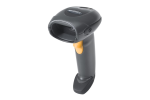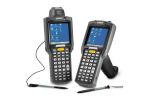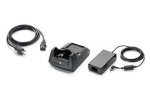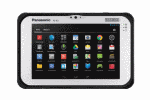We all know what a barcode is, right? Those black vertical lines bound in a rectangular area, printed onto a sticker, stuck onto a package for shipping, or stuck onto some product we are purchasing (and then will be trying to peel off later with not much success!), or printed on our movie ticket. Or, as you may be noticing in recent times, those square-bound areas of pixelated black and white.
But have you ever wondered what a barcode represents, or how barcodes are scanned? Or perhaps you're in need of a barcoding solution for your business but aren't sure where to start. Well, read on, as we take a look into the world of barcodes and barcode scanning.
WHAT EXACTLY ARE BARCODES?
A barcode is essentially a special type of image that encodes information for reading by a machine.
Traditionally, barcodes involve a series of black vertical lines on a white background, with each line or group of lines representing numbers, letters and/or symbols. These are known as 1D barcodes or linear barcodes, as the information is stored in only one direction (dimension) - horizontally (linearly).

Example of a 1D Barcode
In modern times, we are seeing more and more of those square-shaped barcodes. These are conceptually the same as 1D barcodes except that they store information in a matrix format (both horizontally and vertically). These are known as - you guessed it - 2D barcodes or data matrix barcodes. The primary benefit of these 2D (two dimension) barcodes is that they can store significantly more information in the same physical area.

Example of a 2D Barcode
THERE ARE MANY DIFFERENT TYPES OF BARCODES
Barcodes - they are a ubiquitous part of modern society and we're all familiar with them. But have you ever noticed how some barcodes seem to have more lines than others?
The most common barcode you have seen is probably the 1D barcode symbology UPC (Universal Product Code). This barcode is widely used in the USA, Canada, UK, Australia and many other countries, and is mostly used for identifying items in POS (point of sale) processes, using 12 digits to represent a combination of things such as a code for identifying the manufacturer and a code for identifying the product.
Another barcode you will likely have seen is the 2D barcode symbology known as QR Code (Quick Response Code). Even though QR Code originated in Japan for the purposes of tracking parts during vehicle manufacturing, today a very common use of this type of barcode is in mobile advertising. A consumer can use their smartphone's inbuilt camera to scan the code, resulting in something like a new contact being added, or opening up a website, or to even perform financial transactions. Of course they also find use in business processes such as asset tracking, taking the place of traditional 1D barcodes, simply given more information can be stored and retrieved for the asset in question.
These however are only two of many variants of barcode symbologies used throughout the world in various industries and for different purposes. For example there is the stacked linear barcode symbol format PDF417 - a special type of customisable and expandable 1D barcode. Another example is Australia Post's 4-State Barcode - those barcode-like lines you may have seen on printed envelopes.
To see some examples of different barcode symbologies, check out this Bar Code Test Sheet.
I NEED A BARCODE SOLUTION FOR MY ASSETS AND/OR STOCK - WHICH BARCODE DO I CHOOSE?
It of course depends on your needs. Are your barcodes for just internal use only? If so, you can use any of a variety of software solutions to generate any kind of barcode that best suits your needs. But what if your barcodes are used on items that are ultimately traded to/amongst the public? You will then want a barcode that is unique for your asset/stock. In this case, your best bet is to refer to this page to find out if registering your own set of barcode numbers is the way to go:
http://www.gs1.org/10-steps-to-barcode-your-product
Of course, your assets/stock may already be barcoded, and all you are concerned with is scanning the barcodes, which is what we will look at next.
HOW ARE BARCODES SCANNED?
The true power behind barcodes are their machine-friendliness. Barcodes have been specifically designed to be read by machines at speeds much faster than any human. But what are these wondrous machines and how do they work?
The first barcode scanners were in fact pen-type readers. Using a special light-measuring component, the pen would be drawn left-to-right across a 1D barcode, detecting the lines and the gaps between the lines, a bit like Morse code.
The next evolution of barcode scanners were the CCD contact readers. These conceptually work as though there are hundreds of tiny pen-type readers all reading the 1D barcode at once, meaning no swiping involved - a lot quicker and a lot less work! However these CCD readers generally need to be held quite close to the barcode to read successfully. Note that CCD as a technology is still used with some imager-type scanners, which we will cover below.
View our range of CCD Contact Readers.
Laser scanners work similar to the pen-type readers, except a laser is used rather than light. The reading speeds of laser scanners are extremely fast, but they do require the barcode to be accurately aligned with the scanner.
View our range of Laser Barcode Scanners.
An enhancement on traditional the laser scanner are omnidirectional scanners. These barcode scanners use multiple lasers in varying orientations to be able to read barcodes held at any angle and are also better at reading distorted/damaged barcodes, resulting in improved throughput at the point of sale. Some forms of these are small on-counter models, while others are larger in-counter models - yes, if you've used self-service checkout at the supermarket, you personally have used one of these!
View our range of Omnidirectional Barcode Scanners.
Finally there are the imaging devices. These can either be 1D linear imagers or 2D area imagers, to handle 1D and 2D barcodes respectively. These devices essentially use CCD or CMOS technology with a camera and image processing/decoding engines to read the barcode. 1D linear imagers are much the same as the laser scanners in that they read only 1D barcodes and are fast, but the imaging component makes it a device that is much more forgiving of damaged or poorly printed barcodes.
View our range of 1D Linear Imager Barcode Scanners and 2D Area Imager Barcode Scanners.
I'VE GOT MY BARCODES, NOW I NEED A BARCODE SCANNER - WHICH TYPE SHOULD I CHOOSE?
A number of factors come into play when deciding on a barcode scanner, if it is not obvious or specified at the outset.
Do you use 2D barcodes? Then it is a 2D area imager you're after.
Bear in mind what you may be planning for the future; perhaps the extra information storage of 2D barcodes (for storing something such as a website address for automatic newsletter subscription when your customer scans the barcode with their smartphone - yes, most smartphones can read and react to 2D barcodes) is something you might want make use of some day? If so, you might want to invest in a 2D area imager now, given they can read 1D barcodes as well.
If you just use 1D barcodes, then traditionally you will have been choosing a laser scanner. But with the technology of 1D linear imagers improving (now are faster than laser scanners) and the cost decreasing, the linear imager is recommended. They also are more forgiving with poorly printed barcodes. However the range of a linear imager is usually limited to within a foot or two. Laser scanners still have the benefit of their larger range - up to many metres in some cases. Another consideration in the 1D linear imager versus laser scanner debate is laser safety. Although countries around the world have their safety standards - and no device would be allowed for sale if it didn't meet standards - the nature of lasers mean that imagers are inherently safer.
MORE THAN A BARCODE SCANNER
For some industries, scanning the barcode is only part of the job. Take warehousing, where you need to be interacting with a warehouse management system, or stocktaking, where you might need to see numbers as you're scanning. Or essentially any activity that requires you to input or verify information during your scanning duties. That is where mobile computers come into play. These are essentially barcode scanners with screens and keypads (for line workers) or smartphones with attached scanning instruments (for enterprise knowledge workers).

Example of a Mobile Computer
View our range of Mobile Computers for Line Workers and Enterprise Digital Assistant Mobile Computers.
We hope this has been helpful for you, or at least informative! If you would like to read more about barcoding technology, we recommend Intermec’s whitepaper Guide to Scanning Technologies or contact us with any questions you may have.

